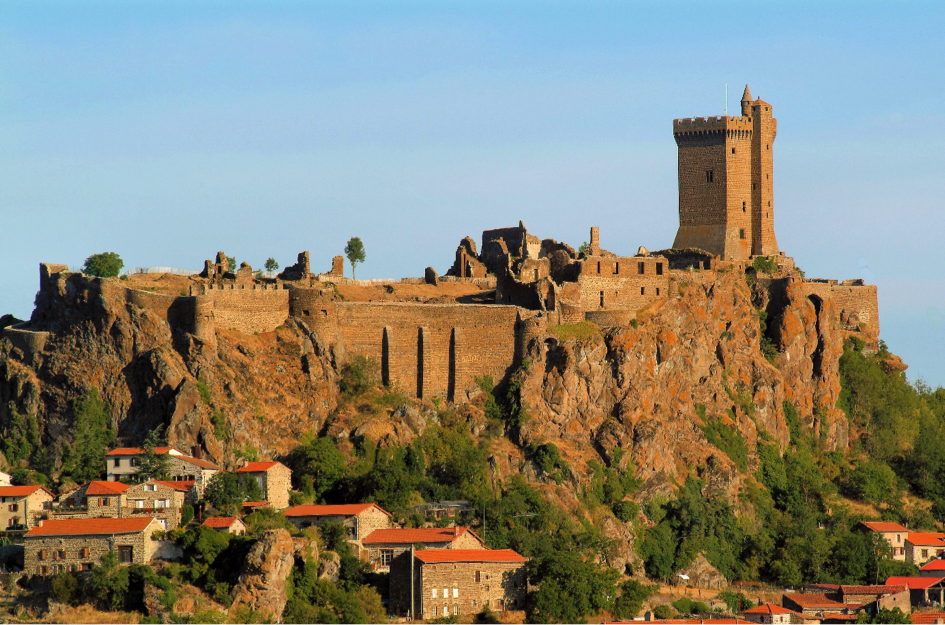
Forteresse de Polignac
The Fortress of Polignac is rooted in the heritage of the Velay region. This thousand-year-old building has stood the test of time and eras. It remains today the witness of a rich and eventful history.
Located 5 km northwest of the city of Le Puy-en-Velay, the Fortress stands on a volcanic hillock, surrounded by steep cliffs. The choice of such a site is not trivial, it gives the fortress a first unique element of defense.
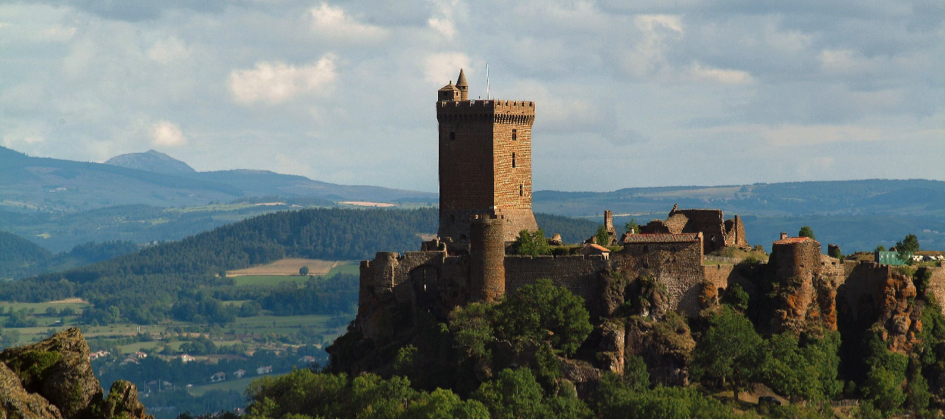
North view – Polignac fortress
This rock results from the meeting between the water which covered the basin of Le Puy en Velay about 3 million years ago, and the lava resulting from volcanic eruptions.
The stone which constitutes the rock is an easy material to cut, a detail the first lords didn’t miss during the construction of the Fortress.
In the 10th century, the rock housed wooden buildings used to defend the northwest entrance of the city of Le Puy-en-Velay. It was at the end of the 11th century that the Viscounts Armand took over the place and took the name of the village, Polignac. Little by little the Fortress rose and remained the allegory of the power of the Lords of Polignac.
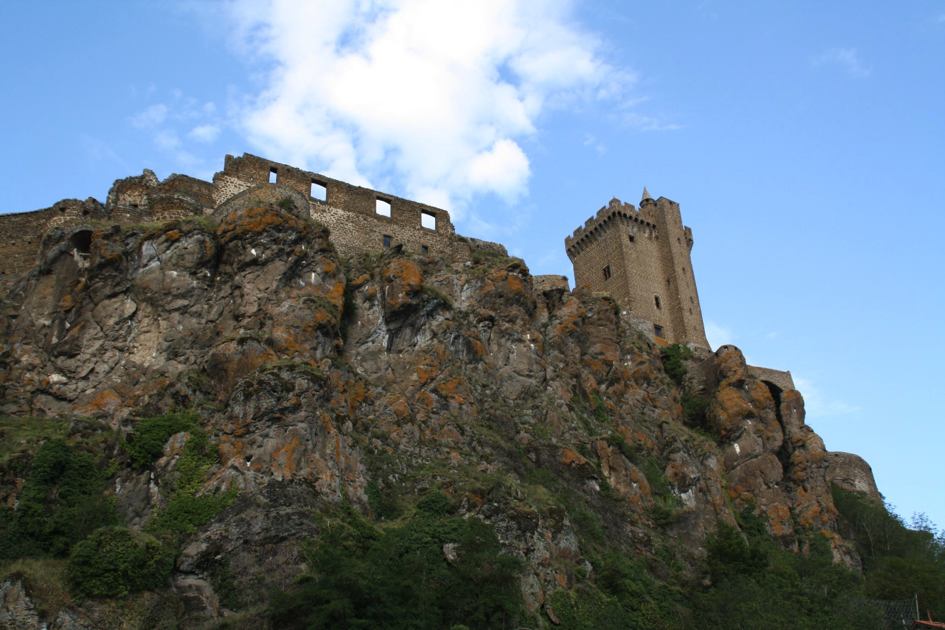
Polignac fortress – The keep and viscountcy
The Fortress has belonged to the Polignac family for almost 1000 years. The various lords marked not only the history of Velay but also the history of France.
Are you wondering what the Fortress looked like in the Middle Ages? Take a look at the model on display at the Hôtel-Dieu of Le Puy-en-Velay:
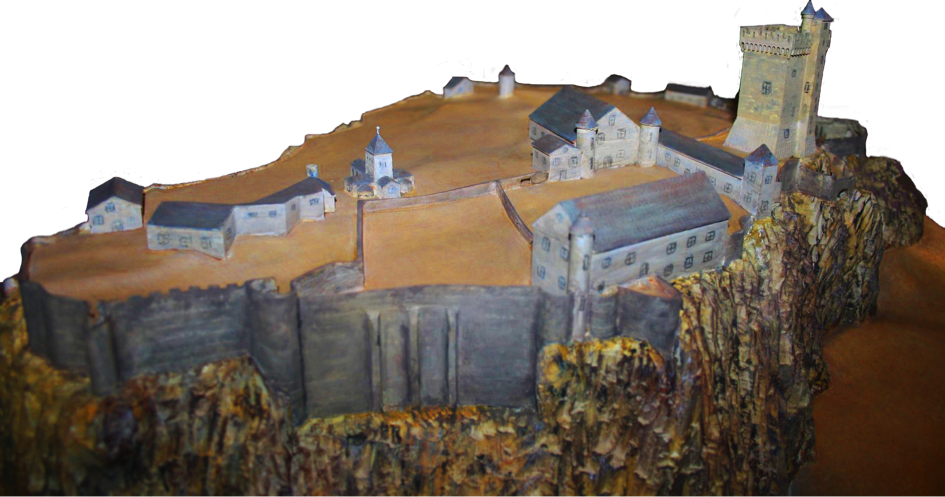
Scale model of the Polignac fortress
A LOOK BACK AT THE KEY MOMENTS IN THE HISTORY OF THE POLIGNACS
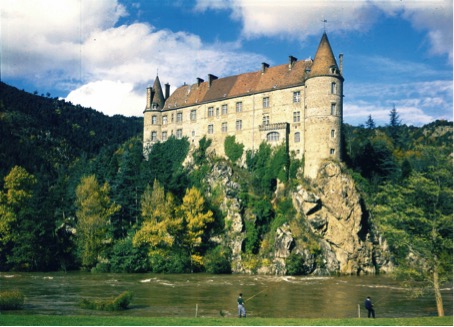
Château of Lavoûte sur Loire
- 1098
Heracle I of Polignac, first lord, took part in the First Crusade in the Holy Land and was killed the same year.
- XIIth and XIIIth century
The lords of Polignac – viscounts of Velay – rose up against the Bishop of Le Puy, then invested with county tasks. An intense rivalry arose between the Polignacs and the powerful religious leader, which led to violent struggles to get the power.
- End of the thirteenth and fourteenth centuries
Relationships calmed down and the power of the Polignac family continued to grow. Occupying the place of first barons due to a marital union with the Chalencon family, they sat at the institution of the States of Velay.
- The Hundred Years War
The famous battle against the English reinforced the fame of the family thanks to Randan Armand X who rid the Velay of enemies. On this occasion, the Fortress took on a new importance in the defense of the region. Between 1385 and 1421, the construction of the imposing 32-meter-high Donjon attested to the omnipotence of the Polignacs.
- 1467
The Polignacs greed for power was curbed that year by the intervention of King Louis XI. The latter severely punished the Polignac family. The Fortress was confiscated and the viscount was briefly imprisoned, in question, his membership in the League of Public Good. The Polignac family was then subject to royal authority.
- End of the 15th century – beginning of the 16th century
The third residence of the Polignacs – the Vicomté – was built within the Fortress. The latter was more modest but much more comfortable and decorated in a more modern way.
- 1533
That year was marked by a prestigious visit, that of King François Ist. The latter, on his way to the town of Le Puy-en-Velay, stopped at the Fortress of Polignac. He was welcomed there with great ceremony. The breathtaking view offered by the Fortress over the entire Velay region and its mountains led the king to nickname the Polignac « The Kings of the Mountains ».
- Wars of Religion – late 16th century
Although the Fortress began to be abandoned by the family in favor of the more comfortable castle of Lavoûte-sur-Loire, it nevertheless lost its decisive military role. The Fortress became the capital of the Royalists and opposed the Ligueurs du Puy, fierce defenders of Catholicism and opponents of King Henri IV, of Protestant origin.
- The Age of Enlightenment
The 17th century marked the withdrawal from the Fortress to the castle of Lavoûte-sur-Loire. Subsequently, the Polignacs, close to the Court, settled in Versailles. They enjoyed the favors of the King, held prestigious positions and were appointed Marquis in 1614.
- XVIIIth century
The De Polignac family still lived in Versailles and Jules Armand XXIII obtained the title of Duke by Louis XVI in 1780, he was the first Duke of Polignac. His wife, Yolande de Polastron, first Duchess of Polignac, was a close friend to Queen Marie-Antoinette.
- During the Revolution
Proximity to the royal family did not bode well for the Polignacs. Louis XVI then summoned them to go into exile. The Fortress of Polignac was confiscated and then sold as National Property.
- 1820
Jules de Polignac, son of Jules Armand XXIII and Yolande de Polastron, was offered the honorary title of Roman prince by the Pope.
- 1830
Prince Jules de Polignac bought the Fortress.
- 1840
The Fortress of Polignac was inscribed on the first list of Historic Monuments by Prosper Mérimée.
- End of the 19th century
After having entered into an alliance with the Pommery family, heir to the Pommery champagnes, the Polignacs could finally finance restoration work within the Fortress which was continued into the 20th century.
- 1920
Numerous marriages with powerful families from the Velay region and France such as the Singer or Pommery families have emerged within the Polignac family. The year 1920 marked the celebration of a princely union. Indeed, Count Pierre de Polignac, grandson of Prince Jules de Polignac, married Charlotte Grimaldi. Being the only heir to the royal family of Monaco, she was not entitled to reign. Count Pierre de Polignac therefore acceded to the title of Prince of Monaco. From their union was born Prince Rainier, father of Prince Albert, current sovereign of the Principality of Monaco.
FOCUS ON THE MOST EMBLEMATIC FIGURES OF THE POLIGNAC FAMILY
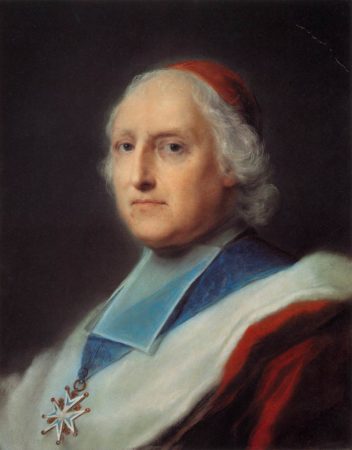
Cardinal Melchior de Polignac
(1661 – 1741)
Born in Lavoûte-sur-Loire in 1661, Melchior de Polignac appears as one of the emblematic figures of the Polignac family. A theology student in Paris, he was quickly noticed thanks to his intelligence and his dazzling social rise. First appointed as Ambassador to Poland by King Louis XIV in 1693, he returned to court in 1701. He wrote a philosophical treatise which would be considered as his life’s work. He was admitted to the Académie Française in 1704.
His title of Cardinal was conferred on him in 1713.
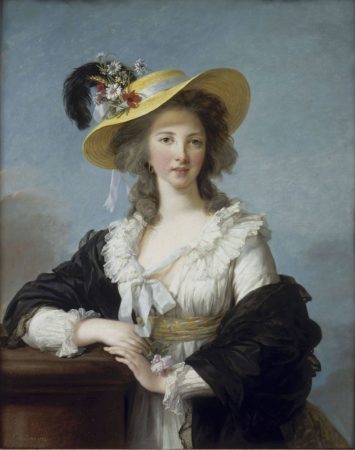
Yolande de Polastron
(1749 – 1793)
Born in Paris in 1749, Yolande de Polastron, also known as Gabrielle de Polignac, married Armand XXII de Polignac in 1767.
In 1775, invited to a ball given at Versailles, her beauty captivated Queen Marie-Antoinette. Yolande de Polastron became a close friend of the queen and the governess of her children.
Following the revolution, she went into exile in Austria, in Vienna. Sick and devastated by the death of Marie Antoinette, she died in 1793.
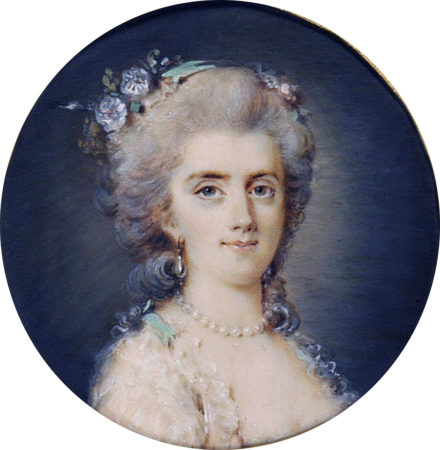
Diane de Polignac
Born in 1882, she was the daughter of Guy de Polignac and Louise Pommery. She married her cousin Henry de Polignac who died in combat in 1915.
After the death of her husband, she devoted her life to helping her neighbor. Thus, she worked in different hospitals and became president of the French Red Cross of Reims.
During the Second World War, she ran the centers for wounded people in Reims.
She was also the co-founder and president of the national work of the Ossuary of Douaumont.
